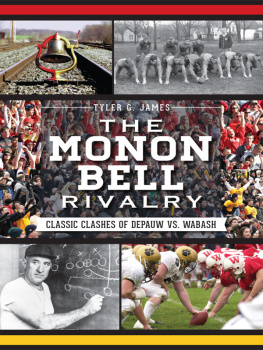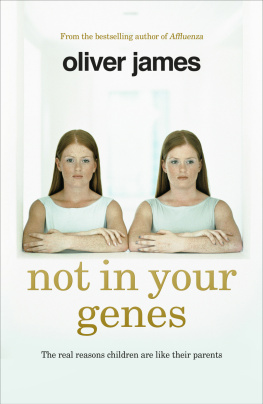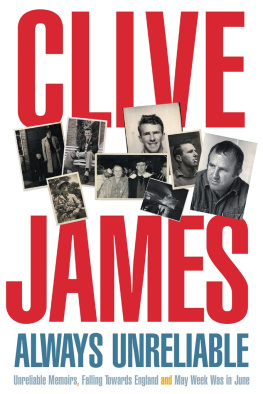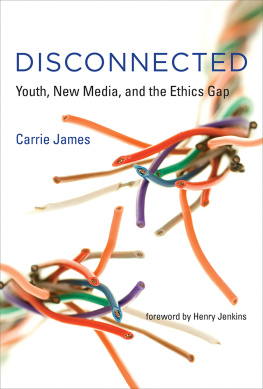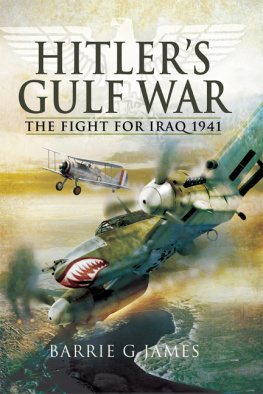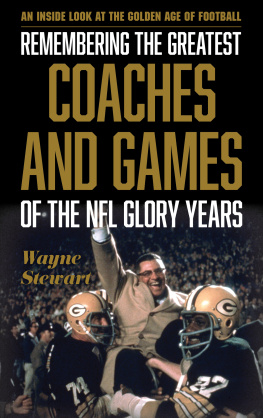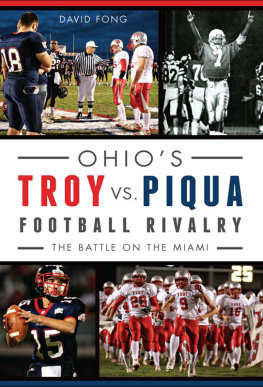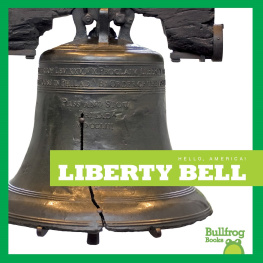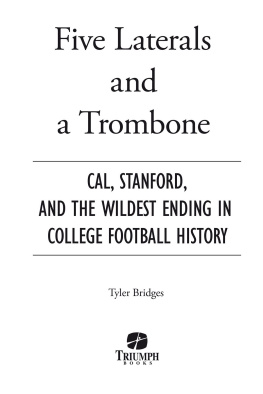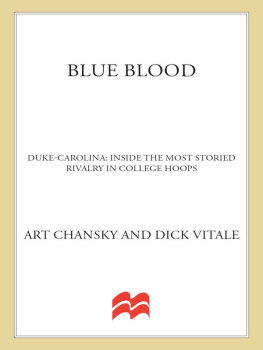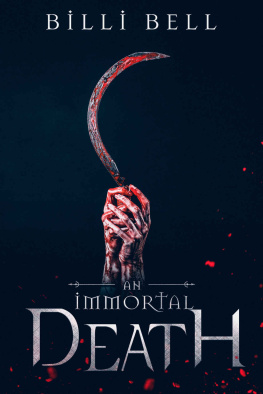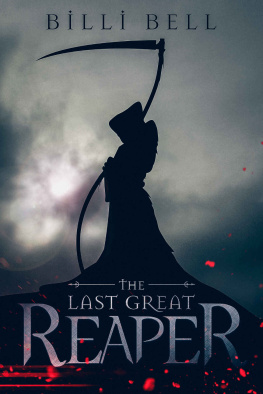

Published by The History Press
Charleston, SC 29403
www.historypress.net
Copyright 2013 by Tyler James
All rights reserved
Cover photo of Wabashs Ralph Lee Wilson (back row, far left) and team courtesy of Crawfordsville District Public Library. Crowd photos of Wabash and DePauw fans courtesy of Alex Turco.
First published 2013
e-book edition 2013
ISBN 978.1.62584.014.1
Library of Congress CIP data applied for.
print edition ISBN 978.1.60949.659.3
Notice: The information in this book is true and complete to the best of our knowledge. It is offered without guarantee on the part of the author or The History Press. The author and The History Press disclaim all liability in connection with the use of this book.
All rights reserved. No part of this book may be reproduced or transmitted in any form whatsoever without prior written permission from the publisher except in the case of brief quotations embodied in critical articles and reviews.
To Ruth for listening, to Greg for pushing and to Mom and Dad for guiding the way.
CONTENTS
ACKNOWLEDGEMENTS
The following people have provided valuable work in making these pages come to life: Bill Wagner, DePauw sports information; Tom Runge, Wabash Alumni Affairs; Beth Swift, Lilly Library archivist; Wes Wilson, Roy O. West Library archivist; Christine DiGangi; Ellen Kobe; and Margaret Distler. Thank you.
INTRODUCTION
They cant even agree on what to call the game. For DePauw, its Monon. For Wabash, its The Bell Game. After 122 years of rivalry between the two schools, disagreements naturally form, even for the silliest reasons. The men of Wabash College, an all-male liberal arts school in Crawfordsville, Indiana, wont always agree with the student body at DePauw University, a coeducational liberal arts school twenty-eight miles south on U.S. Route 231 in Greencastle, Indiana. However, there will always be one agreement: the rivalry renewed annually in the officially-named Monon Bell Classic holds something special.
Matt Walker saw both sides of the rivalry as a young boy. Growing up in Crawfordsville as the son of a DePauw grad, he didnt have an allegiance to either school. One November hed sit on the Wabash side, and the next hed sit with DePauw.
Even then, as a young pup not knowing a lot about what was going on, you still knew it was really different than anything else out there, said Walker, who ended up playing and coaching for DePauw. I didnt know why, because I was a stupid, young kid. I didnt understand. But I could still tell. It was such an intense atmosphere it almost scared me as a young kid. You knew it was special then.
The rivalry has been developed around differencesperceived, created or legitimatebetween two fundamentally similar institutions. At DePauw, they are Tigers, wearing old gold and black. At Wabash, they are Little Giants, colored with scarlet and white. Methodists founded the school in Greencastle. Presbyterians created the institution in Crawfordsville. Wabash calls its rivals Dannies, painting a picture of snooty, rich kids who havent worked a day in their lives. At DePauw, Wabash students are known as Wallies, cavemen creatures grunting in classrooms without women. Even athletic slogans show a split. The Little Giants had Wabash Always Fights, so DePauw countered with DePauw Never Quits.
Some players learned to embrace the rivalry during the recruiting process. Phil Eskews mother wouldnt let him go to an all-male Wabash. Jason Geringer took pride in telling the Wabash coaches that he picked DePauw. Hes missed only one Monon Bell, because of the birth of his first child, since graduating in 2002. I said, I made up my mind to go to DePauw, and the Wabash coach on the phone said, Well Jason, tell me what made that decision. I told him, Coach, honestly I decided I wanted to go to school with girls. And he said, Jason, you mean to tell me youre passing up a quality education just so you can chase tail in biology class? And I said, Coach, if its a choice between chasing tail or not chasing tail, my decision is made.
Dave Husted learned his distaste for DePauw soon after enrolling at Wabash. It was just sort of a given that everybody there disliked DePauw, said Husted. It was one of those things that was sort of drilled into everybody from the beginning. The Dannies were pictured as a little arrogant, carrying umbrellas wherever they went and having all the girlfriends.
For the same reasons DePauw students slight Wabash, those connected to the Crawfordsville college embrace the tradition of the school. Former head coach Chris Creighton spent seven years at Wabash, leaving with a stronger connection to the school than he has to his own alma mater:
I feel more a part of Wabash than I do Kenyon, my alma mater. I love Kenyon, but Im a wannabe alum of Wabash. Wabash College is special. What they do for young men is unlike any place Ive ever heard of. They take motivated and bright young men and challenge them in ways that theyve never been challenged before and basically take these bright, motivated, studly guys to the brink of where I dont know if I can do this. Theyre pushed and challenged to do things that theyd never done before and maybe dont think are possible. Andtheyre supported in unbelievable ways to actually achieve those challenges. Then these guys are the most confident group of people that Ive ever been around. They know that they can go out and make a difference in the world and that there isnt a challenge that they cant overcome. Wabash fundamentally changes its students in that way, and its awesome.
Such passion for a school carries the Monon Bell rivalry through all twelve months of the year. By the time November rolls around, the two schools are ready to fight on (and sometimes off) the field. The opposing crowds are now separated after scuffles between fans escalated in the 1990s. On at least one occasion, the referees made the teams attempt an extra point on the other side of the field from where the touchdown was scored because of a scrum leaking into the end zone.
Those most passionate about the Monon Bell Classic have their own connection to one of the schools. For me, its the school in Greencastle. I first encountered the rivalry as a freshman football player at DePauw in 2007. That game ended with a game-winning field goal as time expired, and Ive been hooked since Jordan Havercamps kick sailed through the uprights for a Tigers victory. Knee injuries cut my career short before I could step onto the playing field for a Monon Bell Classic, but my sideline experience sucked me in. The rest of my college career was spent working for The DePauw, the universitys student-run newspaper. When a scarlet W was spray-painted on a DePauw campus landmark in the fall of 2009, I carried on the time-honored tradition of ripping the opposing school in print. The Tigers havent won a Monon Bell game since that column was published.
The passion of the rivalry, whether expressed through words, vandalism or even thievery, matches anything Ive ever encountered in my short career as a sports journalist. The stories Ive learned while researching this book only reinforced my previous thoughts. Former Wabash quarterback Dave Knott likes to use former Wabash president Andy Ford as the epitome of passion for the rivalry. After Knotts son, Jake, threw a game-winning touchdown pass in 2001 to end a five-year losing streak to DePauw, Ford invited Dave Knott and others to celebrate at his home late into the night. Knott couldnt find anyone happier about the outcome than Ford. He just hated DePauw, and it just killed him when they beat us every year, Knott said. But yet he wanted football to take its proper place. He wanted to win, but he wanted to win within a set rules. He had the perfect mentality.
Next page
